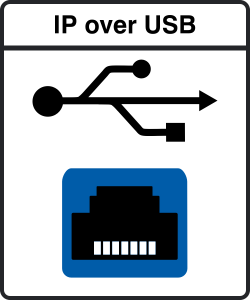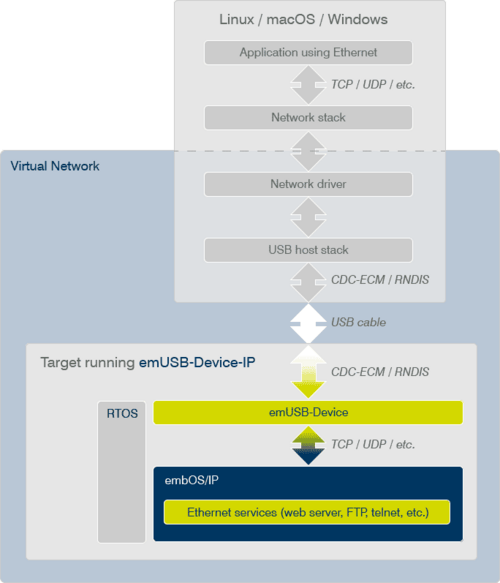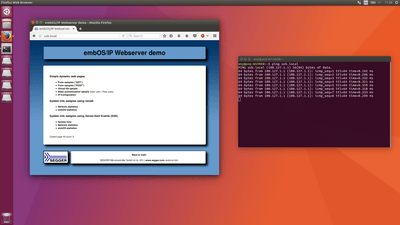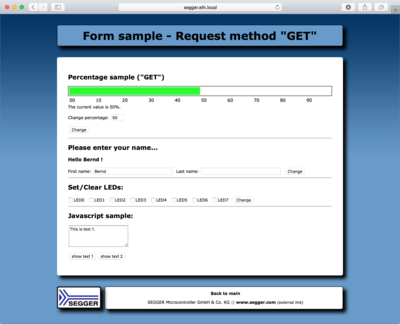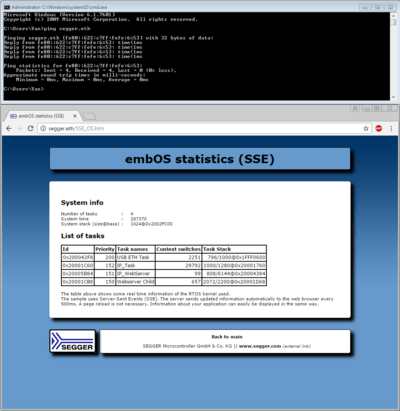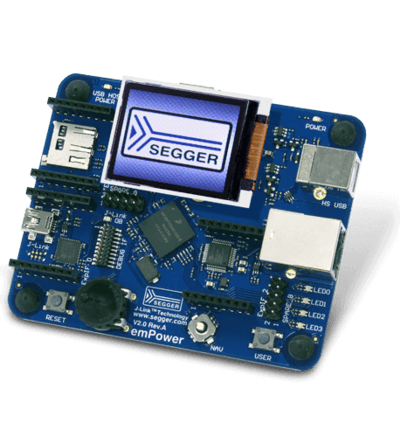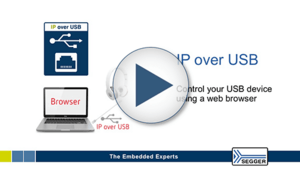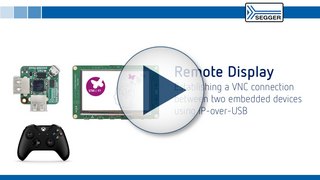We use cookies to make your experience better. To comply with the new e-Privacy directive, we need to ask for your consent to set the cookies. Learn more.
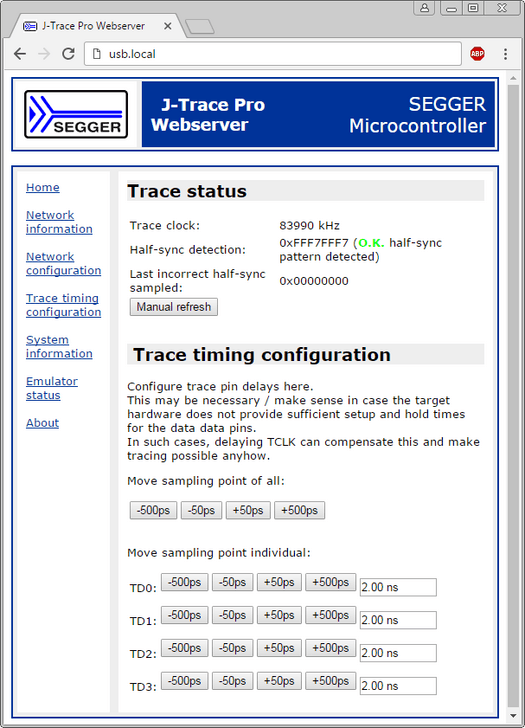
Screenshot of an application sample: SEGGER J-Trace PRO using IP over USB. Status and configuration are easily accessible via web interface.
We believe this to be a must-have for any state-of-the-art USB device:
Using the IP-over-USB technology in combination with a built in web server, the device can easily be accessed from any host (Windows, Linux, Mac) by simply typing the device name into the web browser. The default device name is usb.local. A serial number can be added, even multiple device names (with or without serial number) can be assigned. The end user can access his device more easily than ever before. No setup program, no driver, no special knowledge required. It simply works! This technology is now readily available for any USB device and adds a lot of value by making it user friendly. No need for keys or a display on the unit. Any PC can be used for this purpose. To the left is a screenshot of a web browser connected to a SEGGER J-Trace PRO. The page shown allows adjusting the trace acquisition timing and at the same time visualizes in real time the results of the trace analysis, based on this.
Using the IP-over-USB technology improves the usability of the device and adds value to it. Since all explanations can be shown in the web browser, there is no more need for a paper manual. In addition to this, it can also reduce the manufacturing costs. In the examples below, the printer will in many case have a basic 2 line display, which can now be eliminated. In the case of headphones, some of the buttons may no longer be necessary. Also there is a significant saving for the manufacturer in that he does not have to design, provide and maintain host setup and configuration software.
Any USB device benefits from this technology. We believe that it is a must-have for a modern USB device. Applications can be found in industrial control, medical devices, smart home devices, heating or climate control, consumer devices and more.
Let's look at the following examples:
Bluetooth Headphones
Most of today's noise cancellation, Bluetooth headphones come with a lithium battery that is recharged via a USB cable, typically via a Micro-USB connector. The functionality of these devices is great. However, it can be very challenging to set them up. They do not come with a display and typically just one or two buttons and a switch for ON/OFF position or similar. These devices need to be paired with a Bluetooth host, there might be a set up option for a volume limit (if these devices are handed to kids) and other features that are hard to set up this way. With SEGGER's IP-over-USB technology, that is very easy and intuitive. Anybody can do it, quickly, and a manual is no longer required.
Printer
A web browser is again the easiest way to get information from the device (Why does it not print?), status information (Number of pages printed, percentage of toner left, approximate number of pages left to print). Even more importantly, it is the easiest way to set it up, with things like paper type, paper format, print quality, IP address setup (for device with additional Ethernet connector), color and DPI settings.
A target running emUSB-Device-IP is perceived by the host PC as a network adapter. This can be used to create an USB to Ethernet converter which simply works on plug-in without any drivers. Or it can be used to create a virtual network between the PC and the embedded device. The later makes configuration of the USB device available through a web browser. There is no need to waste money and time to develop software for Linux, macOS or Windows which controls and configures the device. With emUSB-Device-IP the customer can simply use a browser.
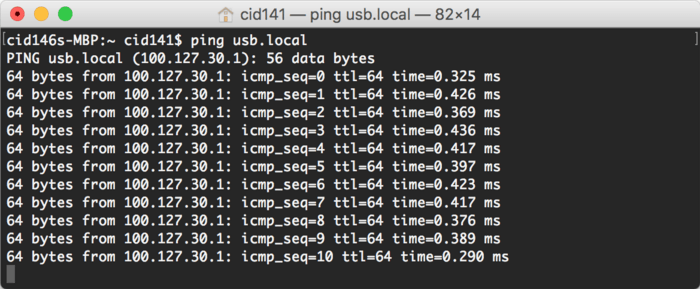
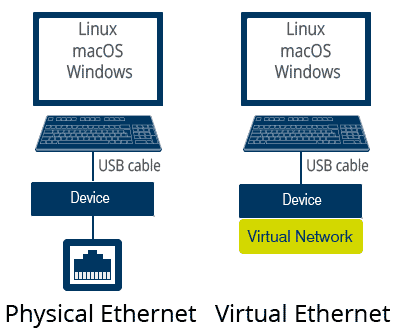
The PC recognizes a target running emUSB-Device-IP as a network adapter. The PC sees a virtual network which is created between the PC and the target.
An application which communicates via Ethernet-based protocols, such as a browser, FTP client or Telnet client is able to access the virtual network created by emUSB-Device-IP the same way it accesses any other network.
For the application the virtual network is transparent and is handled like any other Ethernet network. The application is not aware of the underlying USB connection. Proven protocols and existing Ethernet applications can be used with USB-only devices.
Linux with kernel versions newer than 2.6.22 have full support for emUSB-Device-IP. macOS supports emUSB-Device-IP since version 10.4 (Tiger). Windows XP and newer also support this.
Components
IP-over-USB is implemented using emUSB-Device and embOS/IP. Additionally an RTOS (embOS) is necessary.
- embOS/IP handles the web server role as well as the discovery protocols
- emUSB-Device handles USB communication with the different host operating systems via RNDIS or CDC-ECM
Instead of developing a host application to control your USB device for each of the major operating systems simply create a web page which will work on all of them via Virtual Ethernet.
Create a low-budget version of existing, Ethernet-enabled hardware by using emUSB-Device-IP to deliver IP-based services via USB.
Screenshot of the popular Linux distribution Ubuntu showing ping and the demo web page open in Firefox.
Safari showing a web page delivered with emUSB-Device-IP on macOS.
The ping utility and a demo web site running in Chromium on Windows 7. Implemented using emUSB-Device-IP.
Download the emUSB-Device-IP demo for the emPower board:
• Program the emPower as described here
• Connect the HS USB connector to your PC
• Use the URL "http://usb.local" to open the web server demo over USB
Other Eval packages
IP-over-USB is also available for other boards. Have a look in our
DOWNLOAD SECTION
The following table shows the approximate resource requirements for the complete IP-over-USB solution excluding the web pages:
DescriptionROMRAMemUSB-Device + Driver + IP componentApproximately 15 KByteApproximately 5 KByteembOS/IP + IPv6 + Webserver + DNS + DHCPApproximately 55 KByteApproximately 27 KByteembOSApproximately 4.4 KByteApproximately 3.4 KByte
Values measured in release mode with size optimization
Resource Usage

How to control a USB device using a web browser
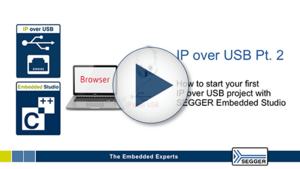
Understanding, compiling and modifying the IP over USB project demo
Establish a VNC connection between two embedded devices using IP-over-USB
• Cross platform works with Linux, Mac, Windows, and other hosts
• Easy to use API and documentation
• Uniform API for all supported controllers
• Small memory footprint
• Direct support from the USB product developers
Tecnologix offers support which is directly handled by development team. Do not hesitate to get in touch with our experts.
Just ask here



